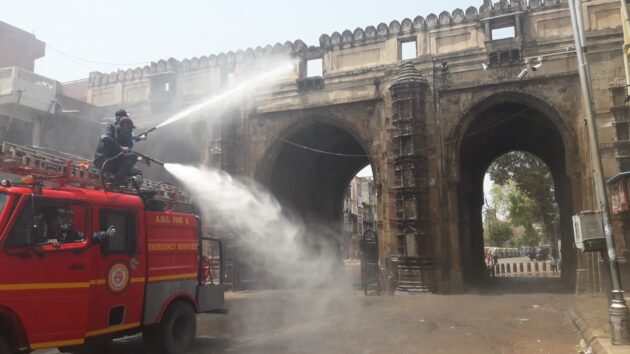
Madhvi Joshi
Genomics researcher and microbiologist
Gujarat Biotechnology Research Centre
A research proposal went from theory to practice in super-quick time when it found surprise application in the COVID-19 pandemic. Its interdisciplinary techniques and new collaborations helped inform vital public health decisions.
The One Health Poultry Hub was less than a year old when SARS CoV-2, the COVID-19 virus, was first detected in China. And it was in the midst of the Hub’s first annual conference, in February 2020, in Gujarat, India, that international travel restrictions began to be imposed and the World Health Organization (WHO) and national health ministries across the world galvanised their efforts to avert calamity.
So it was, that as Hub scientists met to discuss how to implement their plans to investigate the potential pandemic risks of poultry production, that a real-life pandemic, with its roots in another part of the food system, was getting underway.
A central characteristic of the Hub’s proposition was the application of a holistic understanding of disease evolution, emergence and management – this ‘One Health’ approach recognising that the complex science in these areas requires multiple inputs from multiple disciplines. Although one of the Hub’s stated objectives was to investigate how avian influenza (‘bird flu’) viruses move and evolve along poultry production and distribution networks as a means for predicting future pandemics, as the COVID-19 crisis unfolded that same One Health approach could be applied to the novel virus.
From the detection of the first positive COVID-19 cases, it was clear that surveillance would be essential to track transmission of SARS CoV-2. But useful though tracking disease transmission is in an outbreak situation, of even greater value is an understanding of how a fast-evolving virus is mutating as it spreads. Such information is like gold dust to public health decision makers, who can use it to inform the best steps to take to minimise disease spread. For example, it can help them determine if and to what degree social distancing should be recommended, or when and where lockdowns should be imposed.
Phylodynamics is this study of virus genomes and it can be used to gain insights into the infection or epidemic behaviour of viruses. It offers a picture of virus evolution and ecology, showing how a virus mutates as it moves through a population. It is also a powerful way to understand virus transmission dynamics from just a small proportion of sampled infections.
Scientists behind the Hub’s interdisciplinary partnerships quickly refocused their work once SARS CoV-2 was identified. Virtual discussions were convened and a plan put in place: partners skilled in genomic analysis would work closely with modellers on the other side of the world to generate vital information on viral spread and mutation which could inform public health decisions.
Hub scientists worked together to investigate the transmission dynamics of SARS-CoV-2 in Gujarat, India, during the state’s first epidemic wave. Genomic analysis (sequencing) was undertaken at Gujarat Biotechnology Research Centre (GBRC) in Ghandinagar, Gujarat, and then phylodynamic analysis using this data undertaken in the UK at the Royal Veterinary College, University of Oxford and University of Edinburgh.
The use of these new methods to handle millions of sequences had not been seen before. It enabled researchers to investigate the early stages of the SARS-CoV-2 epidemic dynamics in a relatively short period of time.
The scientists were able to reconstruct the epidemic dynamics and spatial spread of SARS-CoV-2 in Gujarat. They showed how international travel was a major driver of the virus and how urban centres contributed disproportionately to the virus’s spread. Ahmedabad, a city of 7.5 million people – and coincidentally the location for the Hub’s first conference – was identified as a significant source of virus exportation within Gujarat.
The continued efforts of GBRC in genomics surveillance led to inclusion of GBRC in the Indian SARS-CoV-2 Genomics Consortium (INSACOG), the pan-India network to monitor genomic variations in SARS-CoV-2 and providing information to high-level public health committees at state and national level in India to aid that country’s public health response. Moreover, GBRC was a core member of the State Pandemic Response Committee that was chaired by the Chief Minister of Gujarat, and genomics surveillance data, regularly updated, were used for appropriate policy decisions during the pandemic.
UK analyses were also communicated to the UK’s Scientific Advice Group for Emergencies (SAGE) and the UK’s Chief Medical Officer and Chief Scientific Officer.
Two and a half years on from the start of the pandemic, GBRC had completed sequencing close to 14,000 SARS CoV-2 genomes.
In addition, GBRC had undertaken wastewater-based surveillance of SARS-CoV-2, the first time the use of wastewater for surveillance was proven to be effective for this virus. Such surveillance requires far fewer samples and less labour than clinical testing to know the presence of infected people in a particular area. It also provides information about emerging variants in the population.
Importantly, the findings from this environmental surveillance enabled GBRC to anticipate what the virus would do and give an early warning of just two weeks of the likely upcoming COVID situation. The protocols used for this work are now referenced in World Health Organization (WHO) guidelines for completing public health environmental surveillance of SARS CoV-2.

Genomics researcher and microbiologist
Gujarat Biotechnology Research Centre